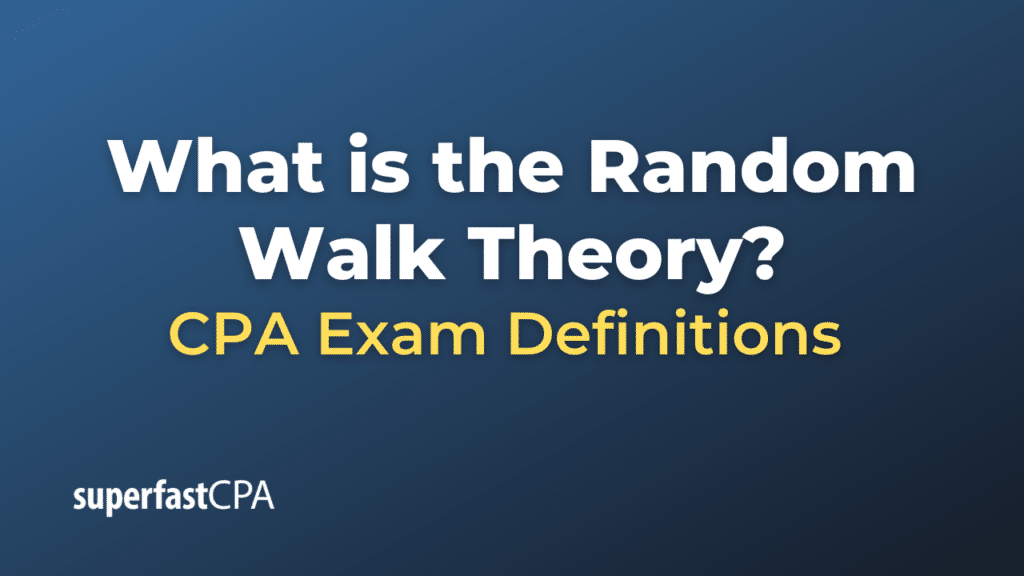Random Walk Theory
The Random Walk Theory asserts that stock market prices evolve according to a random walk and, thus, cannot be predicted. It’s grounded in the belief that the stock market is very efficient, with each successive price reflecting all known information about that stock and the market. Consequently, stock price changes are driven by unforeseen events, making them unpredictable.
Several key ideas stem from the Random Walk Theory:
- Future stock prices are not based on past prices: If stock prices follow a random walk, using past prices to predict future prices would be futile. This challenges technical analysis, which largely depends on studying past stock price movements.
- Short-run price movements are random: In the short term, you can’t reliably predict whether stock prices will go up or down. Prices react to news and events, which are themselves unpredictable.
- The market is efficient: This ties into the Efficient Market Hypothesis (EMH), which argues that at any given time, stock prices already reflect all available information. There are three forms of EMH:
- Weak form: All past market prices and data are already incorporated into stock prices, making technical analysis ineffective.
- Semi-strong form: All publicly available information, not just past prices, is incorporated into stock prices. This suggests neither technical nor fundamental analysis can reliably boost returns.
- Strong form: All information, both public and private, is fully reflected in stock prices. This would imply that even insider information can’t help an investor achieve superior returns.
- It’s hard to consistently outperform the market: If stock price movements are unpredictable and the market efficiently prices in all information, then consistently beating the market becomes a challenging task. Thus, many proponents of the theory advocate for passive investment strategies, such as buying and holding index funds, over active stock-picking.
While the Random Walk Theory has many proponents, especially among academics, it’s not universally accepted. Some investors believe they can achieve superior returns either through analyzing market patterns or through other strategies. However, numerous empirical studies have shown that it’s extremely difficult for active fund managers to consistently outperform the market, lending some weight to the theory.
Example of the Random Walk Theory
Let’s consider a simplified example to illustrate the Random Walk Theory.
Example: Tossing a Coin and Stock Prices
Imagine you’re playing a game where you toss a fair coin:
- Heads: The stock price goes up by $1.
- Tails: The stock price goes down by $1.
Let’s assume the stock’s current price is $100. You toss the coin ten times, and the outcomes are as follows:
Toss 1: Heads (Stock price becomes $101)
Toss 2: Tails (Stock price becomes $100)
Toss 3: Tails (Stock price becomes $99)
Toss 4: Heads (Stock price becomes $100)
…
Toss 10: Heads (Final stock price becomes $102)
Now, each toss of the coin is independent and has no memory of the previous toss. This means that the outcome of each toss (and therefore the short-term price movement) is completely random. Just as you can’t predict the next outcome of the coin toss based on previous results, the Random Walk Theory suggests that stock prices move in a similarly unpredictable fashion, especially in the short term.
If someone tells you they have a strategy to predict the outcome of the next several coin tosses based on the previous results, you’d likely be skeptical. Similarly, proponents of the Random Walk Theory are skeptical about strategies that claim to predict short-term stock price movements based on past data.
This example is a simplified analogy, and real stock prices are influenced by countless factors, including economic data, company earnings, geopolitical events, and investor sentiment. However, the essence of the Random Walk Theory is that these influences are so numerous, varied, and often unexpected, making the exact future movements of stock prices unpredictable.













